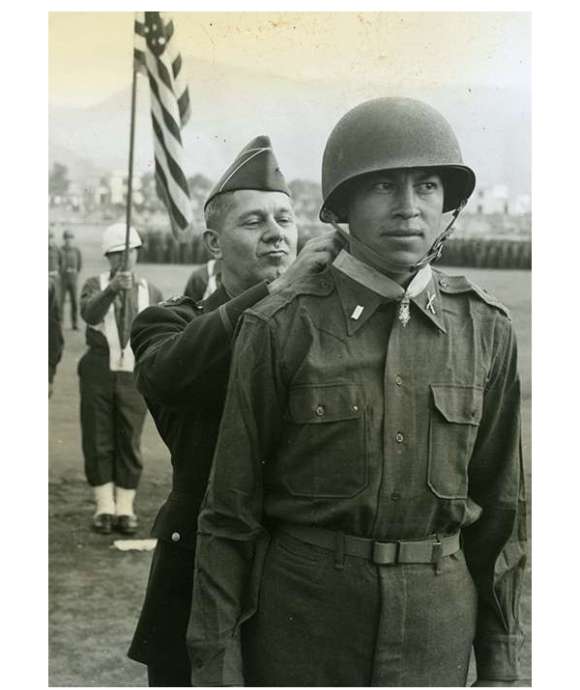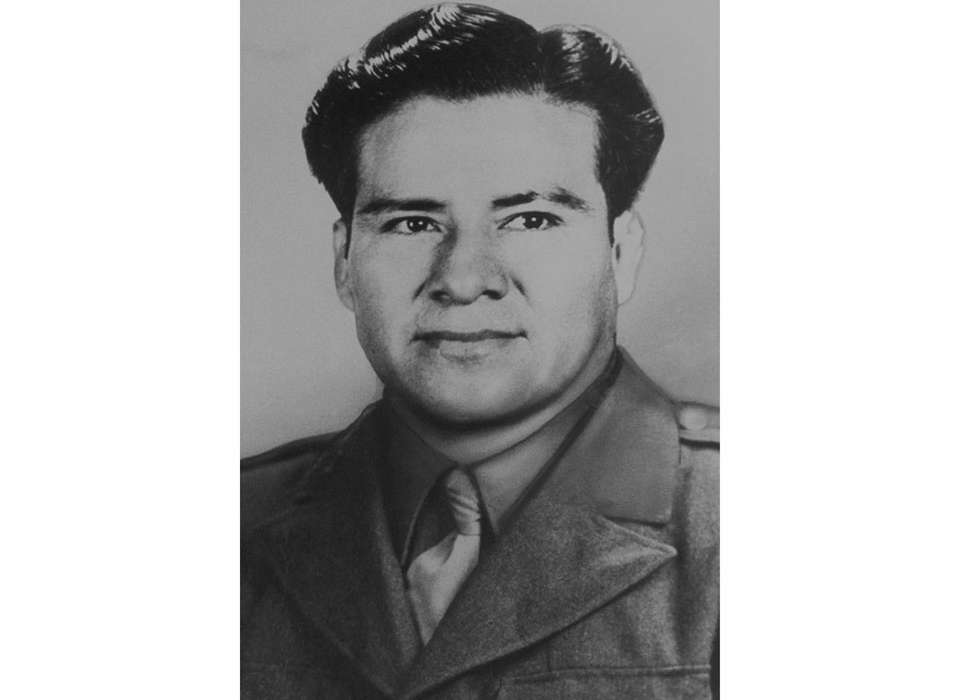Not all American heroes in World War II were born in the United States. Jose Mendoza Lopez was born in Santiago Atitlán, Mexico in 1910. As a young boy, Lopez was orphaned, forcing him to make his way to Texas to live with an uncle. After a stint as a professional boxer from 1927-1934, Lopez joined the Merchant Marine. It was aboard a merchant ship that Lopez learned of the Japanese attack on Pearl Harbor in 1941. When the ship arrived in California, it took some convincing for Lopez to assure authorities he was Mexican, not Japanese, in order to avoid arrest.
In 1942, Lopez had returned to Brownsville, Texas, and married his girlfriend, Emilia Herrera. The couple had little time together before Lopez was drafted into the US Army. Lopez was stationed at Fort Sam Houston in San Antonio, Texas for a short period before he was transferred to Camp Roberts in California for basic training, and was eventually assigned to M Company, 23rd Infantry Regiment, 2nd Infantry Division. The 2nd shipped out to the United Kingdom, where they trained in preparation for the Normandy invasion. The division landed on June 7, and Lopez was wounded that day. But he refused evacuation. The 2nd Division fought in the breakout in Normandy and through to Belgium, where it was located on December 16, when German forces broke through the Allied lines in the Ardennes. In what became known as the Battle of the Bulge, stories of heroics and sacrifice highlighted the determination of the battle-hardened soldiers of the US Army. Sergeant Lopez’s heroic stand near the town of Krinkelt, Belgium is one of those incredible stories of men who put their fellow soldiers before themselves.
As German forces were breaking through, the 33-year-old Lopez had been temporarily attached to K Company, 23rd Infantry Regiment to provide additional support with his machine gun. During the action for which he received the Medal of Honor, Lopez repositioned his machine gun several times. A fact that may not sound very impressive until one takes into consideration that machine guns were usually operated by a team, with several men responsible for relocating the heavy weapon, its tripod, and the copious amount of ammunition required to make the weapons team effective. With no regard for his own safety, and acting entirely alone, Lopez held off oncoming German forces long enough to allow K Company to withdraw and continue the fight from a more advantageous position.
For his actions on December 17, 1944, near Krinkelt, Belgium, Lopez was awarded the Medal of Honor, which was presented to him by Major General James Van Fleet on June 18, 1945 in Nuremberg, Germany. He returned home shortly thereafter, receiving a hero’s welcome in New York, where Mayor Fiorello LaGuardia greeted him. His new country was not the only one to recognize his bravery. During a pilgrimage to the Basilica of Our Lady of Guadalupe in Mexico City, Lopez was awarded Mexico’s highest military award, la Condecoración del Mérito Militar. Lopez credited his return home to his wife and children to his beloved Virgin of Guadalupe, the Patron Saint of Mexico, to whom he had prayed for protection throughout the war. Struggling to find decent work in Texas, Lopez reenlisted in the US Army in 1949. He retired from the army in 1973 with the rank of master sergeant.
MEDAL OF HONOR CITATION
“On his own initiative, he carried his heavy machine gun from Company K's right flank to its left, in order to protect that flank, which was in danger of being overrun by advancing enemy infantry supported by tanks. Occupying a shallow hole offering no protection above the waist, he cut down a group of 10 Germans. Ignoring enemy fire from an advancing tank, he held his position and cut down 25 more enemy infantry attempting to turn his flank. Glancing to his right, he saw a large number of infantry swarming in from the front. Although dazed and shaken from enemy artillery fire which had crashed into the ground only a few yards away, he realized that his position soon would be outflanked. Again, alone, he carried his machine gun to a position to the right rear of the sector; enemy tanks and infantry were forcing a withdrawal. Blown over backwards by the concussion of enemy fire, he immediately reset his gun and continued his fire. Singlehanded he held off the German horde until he was satisfied his company had effected its retirement. Again he loaded his gun on his back and in a hail of small-arms fire he ran to a point where a few of his comrades were attempting to set up another defense against the onrushing enemy. He fired from this position until his ammunition was exhausted. Still carrying his gun, he fell back with his small group to Krinkelt. Sgt. Lopez's gallantry and intrepidity, on seemingly suicidal missions in which he killed at least 100 of the enemy, were almost solely responsible for allowing Company K to avoid being enveloped, to withdraw successfully, and to give other forces coming up in support time to build a line which repelled the enemy drive.”

Medal of Honor Series
Our Nation’s highest military award for valor is given for action above and beyond the call of duty. This series profiles the stories of WWII Medal of Honor recipients.
Kali Martin
Kali Martin is a former Research Historian of The National WWII Museum's Jenny Craig Institute for the Study of War and Democracy.
Cite this article:
MLA Citation:
APA Citation:
Chicago Style Citation:






![Max Fuchs, New York City cantor, sings as Rabbi Sydney [sic] Lefkowitz, Richmond, VA, conducts the first Jewish services from Germany.](/sites/default/files/styles/max_650x650/public/2025-10/image1.jpg)


